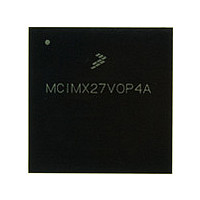MCIMX27VOP4A Freescale, MCIMX27VOP4A Datasheet - Page 10

MCIMX27VOP4A
Manufacturer Part Number
MCIMX27VOP4A
Description
Manufacturer
Freescale
Datasheet
1.MCIMX27VOP4A.pdf
(152 pages)
Specifications of MCIMX27VOP4A
Lead Free Status / RoHS Status
Compliant
Available stocks
Company
Part Number
Manufacturer
Quantity
Price
Company:
Part Number:
MCIMX27VOP4A
Manufacturer:
FREESCAL
Quantity:
410
Company:
Part Number:
MCIMX27VOP4A
Manufacturer:
FREESCALE
Quantity:
586
Company:
Part Number:
MCIMX27VOP4A
Manufacturer:
Freescale Semiconductor
Quantity:
10 000
Part Number:
MCIMX27VOP4A
Manufacturer:
FREESCALE
Quantity:
20 000
Company:
Part Number:
MCIMX27VOP4AR2
Manufacturer:
FREESCALE
Quantity:
1 948
Company:
Part Number:
MCIMX27VOP4AR2
Manufacturer:
Freescale Semiconductor
Quantity:
10 000
Functional Description and Application Information
2.3.2
The AIPI acts as an interface between the ARM Advanced High-performance Bus Lite. (AHB-Lite) and
lower bandwidth peripherals conforming to the IP bus specification Rev 2.0. There are two AIPI modules
in i.MX27/MX27L processors.
The following list summarizes the key features of the AIPI:
2.3.3
The ARM926EJ-S Interrupt Controller (AITC) is a 32-bit peripheral that collects interrupt requests from
up to 64 sources and provides an interface to the ARM926EJ-S core. The AITC includes software
controlled priority levels for normal interrupts.
The AITC performs the following functions:
2.3.4
The ARM926EJ-S (ARM926) is a member of the ARM9 family of general-purpose microprocessors
targeted at multi-tasking applications. The ARM926 supports the 32-bit ARM and 16-bit Thumb
instructions sets. The ARM926 includes features for efficient execution of Java byte codes. A JTAG port
is provided to support the ARM Debug Architecture, along with associated signals to support the ETM9
real-time trace module. The ARM926EJ-S is a Harvard cached architecture including an ARM9EJ-S
integer core, a Memory Management Unit (MMU), separate instruction and data AMBA AHB interfaces,
separate instruction and data caches, and separate instruction and data tightly coupled memory (TCM)
interfaces. The ARM926 co-processor, instruction TCM, and data TCM interfaces will be tied off within
the ARM926 Platform and will not be available for external connection.
10
•
•
•
•
•
•
•
•
•
•
•
•
•
All peripheral read transactions require a minimum of two system clocks (R-AHB side) and all
write transactions require a minimum of three system clocks (R-AHB side).
The AIPI supports 8-bit, 16-bit, and 32-bit IP bus peripherals. Byte, half word, and full word reads
and writes are supported.
The AIPI supports multi-cycle accesses by providing 16-bit to 8-bit peripherals operations and
32-bit to both 16-bit and 8-bit peripherals operations.
The AIPI supports 31 external IP bus peripherals each with a 4-Kbyte memory map (a slot).
Supports up to 64 interrupt sources
Supports fast and normal interrupts
Selects normal or fast interrupt request for any interrupt source
Indicates pending interrupt sources via a register for normal and fast interrupts
Indicates highest priority interrupt number via register. (Can be used as a table index.)
Independently can enable or disable any interrupt source
Provides a mechanism for software to schedule an interrupt
Supports up to 16 software controlled priority levels for normal interrupts and priority masking
Can single-bit disable all normal interrupts and all fast interrupts. (Used in enabling of secure
operations.)
AHB-Lite IP Interface Module (AIPI)
ARM926EJ-S Interrupt Controller (AITC)
ARM926EJ-S Platform
i.MX27 and i.MX27L Data Sheet, Rev. 1.6
Freescale Semiconductor
























